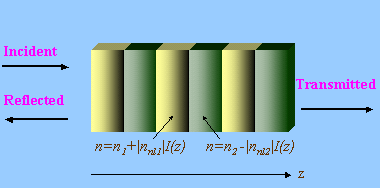Light Transmission in Photonic Gratings
Nonlinear periodic optical structures are promising building blocks
for functional, multi - wavelength photonic systems. With enhanced
control, confinement, and manipulation of light waves, photonic
bandgap structures provide new revolutionary horizonts for creating
of parallel, all-optical computing and high-speed digital
all-optical networking. The studies of nonlinear periodic optical
structures focus on properties of new compact, modular and functional
photonic devices.
 Optical gratings can be manufactured from alternating bulk layers of
photonic crystals with different linear refractive indices and
different Kerr nonlinearities. Transmission of light through
the periodic material is simultaneously wavelength- and
intensity-dependent.
Optical gratings can be manufactured from alternating bulk layers of
photonic crystals with different linear refractive indices and
different Kerr nonlinearities. Transmission of light through
the periodic material is simultaneously wavelength- and
intensity-dependent.
The periodic modulation of the linear refractive index induces
a spectral gap in the material's bandwidth. The gap becomes
wider with larger modulation depth (contrastness). The incident wave
which wavelength fits inside the linear forbidden bandgap excites
a resonant, strongly coupled counter-propagating wave.
The resulting transmission is supported by the intensity-dependent
refraction of the optical structure.
 The forbidden bandgap
is centered at a selected wavelength which satisfies the
condition for Bragg resonance between the light and
the optical material. The first bandgap occurs when
the light wavelength matches the double period of
the optical structure multiplied by the average
linear refractive index. It is the largest gap for
small modulation debth. There exist higher-order
bandgaps for smaller values of the light wavelength.
However, the higher-order bandgaps are narrow for small
modulation debth.
The forbidden bandgap
is centered at a selected wavelength which satisfies the
condition for Bragg resonance between the light and
the optical material. The first bandgap occurs when
the light wavelength matches the double period of
the optical structure multiplied by the average
linear refractive index. It is the largest gap for
small modulation debth. There exist higher-order
bandgaps for smaller values of the light wavelength.
However, the higher-order bandgaps are narrow for small
modulation debth.
Mathematical modeling of optical gratings starts with
the Maxwell equations, where the refractive index is
periodic along the structure:
n(z) = n0(z) + n2(z)
I(z,t). Here I(z,t) is
local intensity of light. Near the Bragg resonance,
the electric field E(z,t) can be
decomposed into two coupled modes for amplitudes
of the forward (incident) wave A(z,t)
and the backward (reflected) wave B(z,t):
E(z,t) = A(z,t) exp[i(kz - ωt)] + B(z,t) exp[-i(kz + ωt)]
In this approximation, the Maxwell equations can be
reduced to a coupled-mode system. Basic types of
the coupled-mode system are presented below for
different physical approximations. Select
the approximation on the left and check the type of
the coupled-mode system on the right.
|
|
|
In the applet above, we have used the following notations:
|
Derivatives:
|
A' = dA/dz + dA/dt;
B' = dB/dz - dB/dt;
|
|
Parameters:
|
c - average of n0(z);
d - average of n2(z);
e - variance of n2(z).
|

|
Guess what physical quantity conserved by the coupled-mode
equations for time-independent light transmission
through the periodic structure?!
|

|
 Optical gratings can be manufactured from alternating bulk layers of
photonic crystals with different linear refractive indices and
different Kerr nonlinearities. Transmission of light through
the periodic material is simultaneously wavelength- and
intensity-dependent.
Optical gratings can be manufactured from alternating bulk layers of
photonic crystals with different linear refractive indices and
different Kerr nonlinearities. Transmission of light through
the periodic material is simultaneously wavelength- and
intensity-dependent.
 The forbidden bandgap
is centered at a selected wavelength which satisfies the
condition for Bragg resonance between the light and
the optical material. The first bandgap occurs when
the light wavelength matches the double period of
the optical structure multiplied by the average
linear refractive index. It is the largest gap for
small modulation debth. There exist higher-order
bandgaps for smaller values of the light wavelength.
However, the higher-order bandgaps are narrow for small
modulation debth.
The forbidden bandgap
is centered at a selected wavelength which satisfies the
condition for Bragg resonance between the light and
the optical material. The first bandgap occurs when
the light wavelength matches the double period of
the optical structure multiplied by the average
linear refractive index. It is the largest gap for
small modulation debth. There exist higher-order
bandgaps for smaller values of the light wavelength.
However, the higher-order bandgaps are narrow for small
modulation debth.

